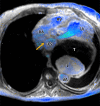Left Circumflex Coronary Artery-to-Coronary Sinus Fistula with Coronary Sinus Ostial Atresia and a Persistent Left Superior Vena Cava in an Adult Patient
- PMID: 35782758
- PMCID: PMC8893212
- DOI: 10.1148/ryct.210249
Left Circumflex Coronary Artery-to-Coronary Sinus Fistula with Coronary Sinus Ostial Atresia and a Persistent Left Superior Vena Cava in an Adult Patient
Abstract
Understanding of coronary sinus (CS) anatomy and abnormalities is of critical importance due to their use in interventional procedures. Herein, the authors report a rare case of an asymptomatic 72-year-old man with a left circumflex coronary artery-to-CS fistula, together with CS ostial atresia and persistent left superior vena cava. These findings are described using both cardiac CT angiography and MRI with four-dimensional flow for anatomic and functional assessment. Keywords: Cardiac, Coronary Sinus, Aneurysms, Fistula, CT Angiography, MR Imaging Supplemental material is available for this article. © RSNA, 2022.
Keywords: Aneurysms; CT Angiography; Cardiac; Coronary Sinus; Fistula; MR Imaging.
2022 by the Radiological Society of North America, Inc.
Conflict of interest statement
Disclosures of Conflicts of Interest: V.F.M. No relevant relationships. A.H. Research grants from GE Healthcare and Bayer; patent, royalties, and licenses from Stanford University for “Comprehensive Cardiovascular Analysis with Volumetric Phase-Contrast MRI”; founder shares in Arterys. S.K. Deputy editor for Radiology: Cardiothoracic Imaging. S.S.B. No relevant relationships.
Figures




References
-
- Shah SS , Teague SD , Lu JC , Dorfman AL , Kazerooni EA , Agarwal PP . Imaging of the coronary sinus: normal anatomy and congenital abnormalities . RadioGraphics 2012. ; 32 ( 4 ): 991 – 1008 . - PubMed
-
- Mantini E , Grondin CM , Lillehei CW , Edwards JE . Congenital anomalies involving the coronary sinus . Circulation 1966. ; 33 ( 2 ): 317 – 327 . - PubMed
-
- Xie M , Li L , Cheng TO , et al. . Coronary artery fistula: comparison of diagnostic accuracy by echocardiography versus coronary arteriography and surgery in 63 patients studied between 2002 and 2012 in a single medical center in China . Int J Cardiol 2014. ; 176 ( 2 ): 470 – 477 . - PubMed
-
- Santoscoy R , Walters HL 3rd , Ross RD , Lyons JM , Hakimi M . Coronary sinus ostial atresia with persistent left superior vena cava . Ann Thorac Surg 1996. ; 61 ( 3 ): 879 – 882 . - PubMed

